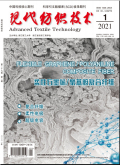现代纺织技术2024,Vol.32Issue(5):9-17,9.DOI:10.19398/j.att.202311024
丝素-聚苯胺复合纳米纤维膜的制备及其性能
Preparation and antibacterial properties of silk fibroin-polyaniline composite nanofiber membranes
摘要
Abstract
This article used electrospinning technology to prepare composite antibacterial(SF PANI)dressings with polyaniline(PANI)and regenerated silk fibroin(SF)as raw materials.Silk fibroin is a structural protein that is spun into fibers by thousands of arthropods and used in vitro.It is a natural high molecular fiber protein and is often used as an ideal dressing for repairing oral,maxillofacial,and systemic skin wounds.The modification of silk fibroin materials with different antibacterial properties has received extensive research and attention.Finished silk fibroin is obtained by degumming,dialysis,and freeze-drying of silkworm cocoons.Due to the easy availability of raw materials,diverse chemical structures,simple synthesis methods,unique doping mechanisms,low cost,and good biological stability,polyaniline functionalized derivatives are a new type of antibacterial agent with the potential to provide anti-fouling surfaces as non-leaching additives,and have broad prospects in textile-based flexible applications. Electrospinning is a simple,cost-effective,and controllable method for preparing nanofibers or microfibers from polymers in solution or melt state under high voltage electric fields.Through scanning electron microscopy(SEM),it can be seen that as the PANI content in the SF-PANI composite nanofiber membrane increases,the fiber diameter of the composite membrane gradually decreases from a microscopic perspective,and becomes more and more uneven in thickness.From a macro perspective,with the increase of PANI content,the overall color of the nanocomposite fiber membrane changes from pure white to dark green.The chemical composition and structure of PANI were characterized by instruments such as infrared spectroscopy(FTIR)and X-ray powder diffraction(XRD).It was found that PANI was successfully loaded on the SF fiber membrane,and the addition of PANI did not react with SF to produce a new chemical structure.By analyzing the swelling and porosity of the SF-PANI composite fiber membrane,it can be concluded that the overall performance of the composite membrane meets the basic requirements for antibacterial materials.From the mechanical properties of the composite membrane,it can be seen that as the PANI content gradually increases,the mechanical properties of the composite membrane first increase and then decrease.When the PANI content reaches 2%,the mechanical properties are the best.This article studied the antibacterial properties of composite membranes before and after halogenation.It can be seen that before halogenation treatment,the SF-PANI composite nanofiber membrane has good antibacterial performance against Staphylococcus aureus and Escherichia coli.After halogenation,its antibacterial mechanism undergoes a transformation.Compared with the original antibacterial property of polyaniline,N-halogenation releases strong oxidizing poplar ions,which destroy the bacterial cell membrane and enter into the bacterial body,affecting the metabolic process and activity of cellular enzymes,and eventually the bacteria die. The results indicate that the chemical composition of the SF-PANI composite nanofiber membrane prepared in this article does not change with the content and modification of polyaniline,and the SF-PANI composite nanofiber membrane has good pore swelling and mechanical properties.It has good application prospects in terms of antibacterial activity against Escherichia coli and Staphylococcus aureus.关键词
聚苯胺/丝素蛋白/静电纺丝/卤化处理/抗菌性能Key words
polyaniline/silk fibroin/electrospinning/halogenation/antimicrobial properties引用本文复制引用
周家宝,刘涛,仇巧华,朱灵奇,王艳敏,丁新波..丝素-聚苯胺复合纳米纤维膜的制备及其性能[J].现代纺织技术,2024,32(5):9-17,9.基金项目
国家自然科学基金项目(37900964) (37900964)
浙江理工大学科研启动基金项目(11150131722120) (11150131722120)

